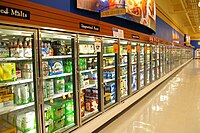
Photo from wikipedia
Assuring the safety of muscle foods and seafood is based on prerequisites and specific measures targeted against defined hazards. This concept is augmented by ‘interventions’, which are chemical or physical… Click to show full abstract
Assuring the safety of muscle foods and seafood is based on prerequisites and specific measures targeted against defined hazards. This concept is augmented by ‘interventions’, which are chemical or physical treatments, not genuinely part of the production process, but rather implemented in the framework of a safety assurance system. The present paper focuses on ‘Cold Atmospheric pressure Plasma’ (CAP) as an emerging non-thermal intervention for microbial decontamination. Over the past decade, a vast number of studies have explored the antimicrobial potential of different CAP systems against a plethora of different foodborne microorganisms. This contribution aims at providing a comprehensive reference and appraisal of the latest literature in the area, with a specific focus on the use of CAP for the treatment of fresh meat, fish and associated products to inactivate microbial pathogens and extend shelf life. Aspects such as changes to organoleptic and nutritional value alongside other matrix effects are considered, so as to provide the reader with a clear insight into the advantages and disadvantages of CAP-based decontamination strategies.
Journal Title: Foods
Year Published: 2022
Link to full text (if available)
Share on Social Media: Sign Up to like & get
recommendations!